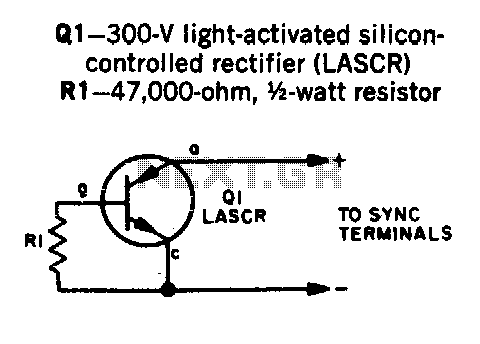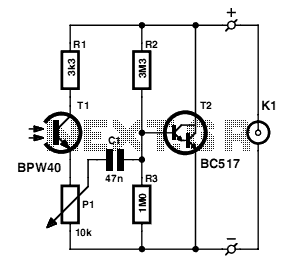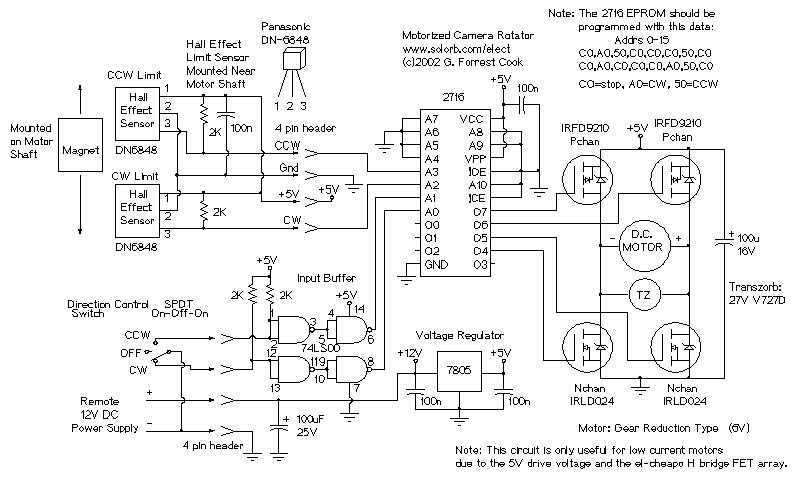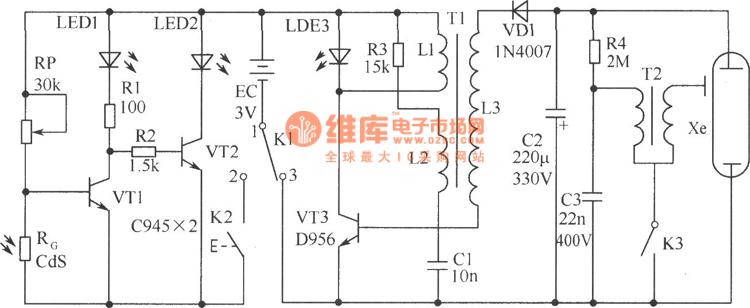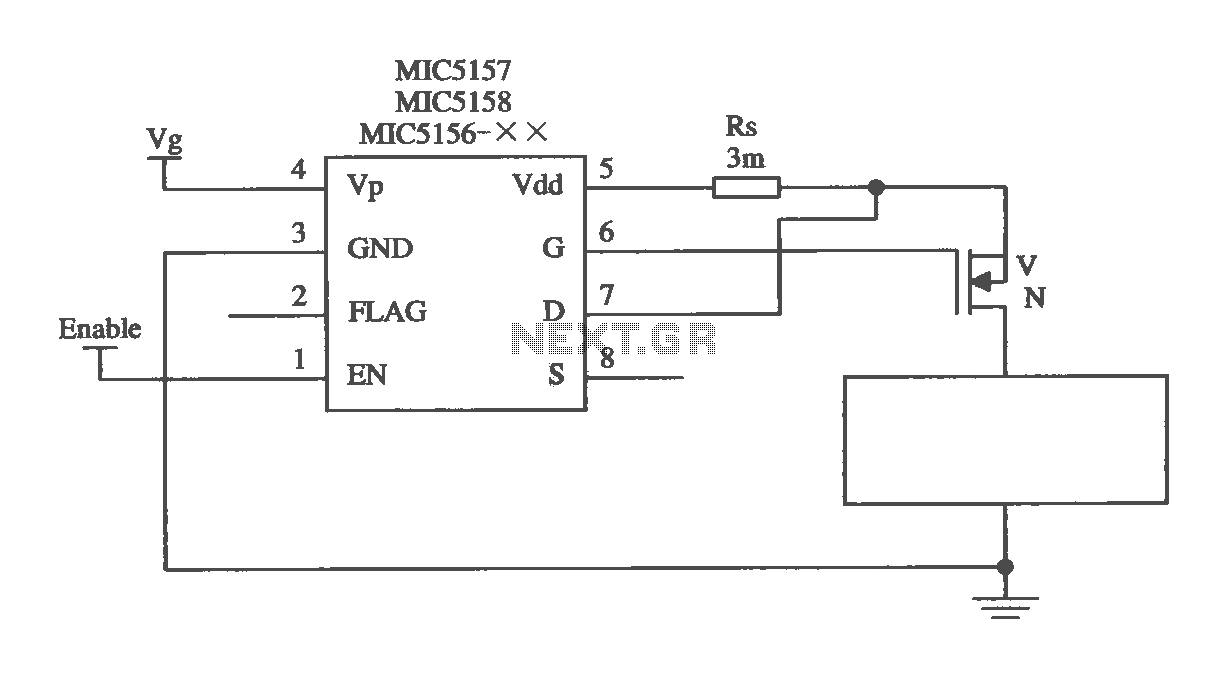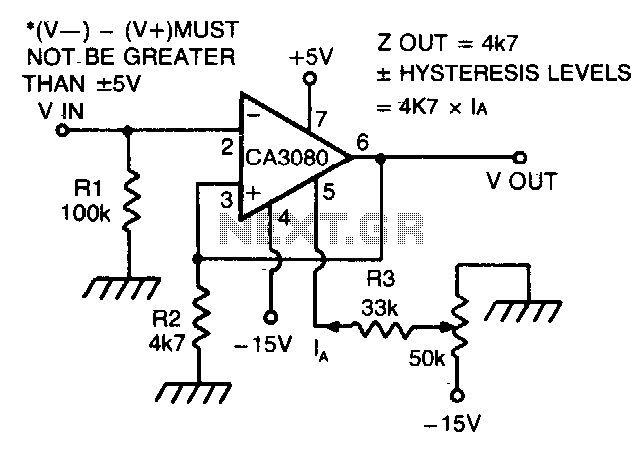
home-made light-operated camera trigger
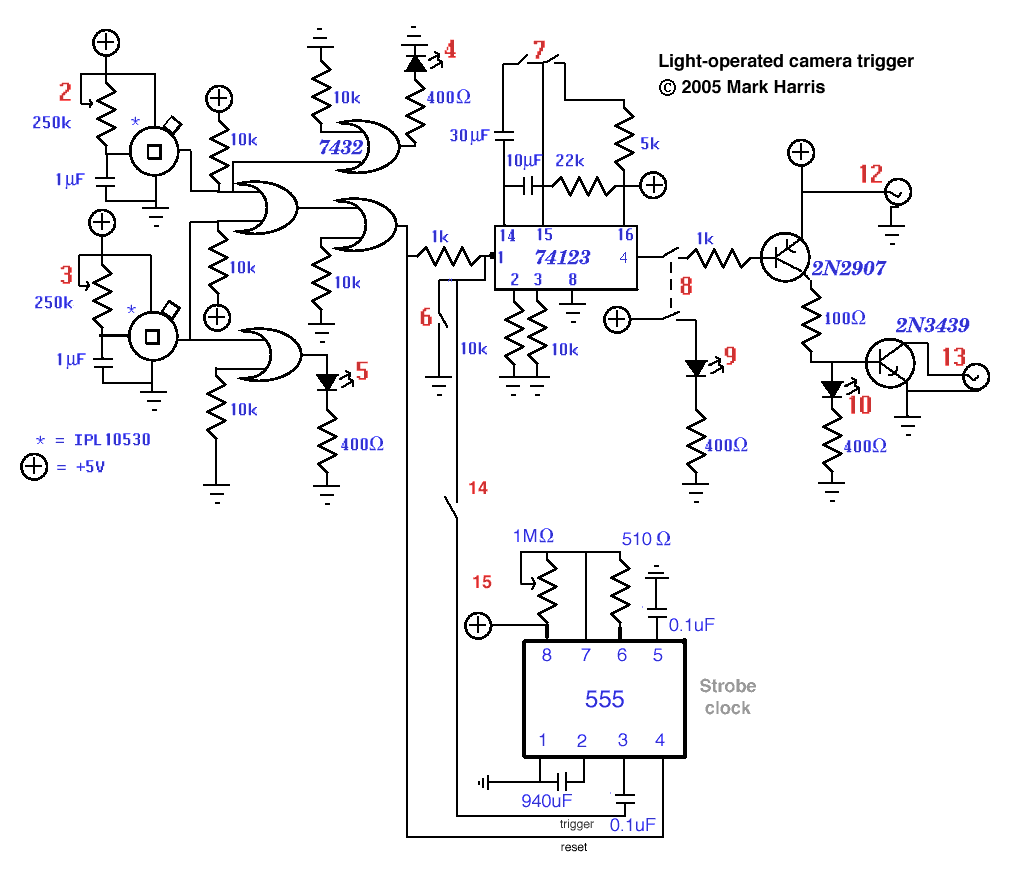
This device is designed to capture images of moving objects by activating a camera or flashgun when one or two light beams are interrupted. Originally intended for photographing insects in flight, it can also be utilized for projectiles and other fast-moving subjects that cannot be captured manually. The construction cost is approximately $30, and it was utilized in creating The Barista Collection. Several commercial triggers exist, such as The Time Machine, which typically utilize a single beam that activates the camera upon interruption anywhere along its length. In contrast, this device offers the option of a second beam positioned perpendicular to the first, resulting in a smaller triggering area and minimizing out-of-frame subjects. Additionally, it is more cost-effective and can be modified for specialized tasks. The circuit diagram is available for reference. Assembling the device may require some electronics experience; for those seeking a simpler alternative, the CamTrigJunior is suggested. If the IPL530 (DAL) is difficult to source, alternatives include using a phototransistor as found in the CamTrigJunior. To operate the trigger, connect the sensor cable to the 8-pin DIN socket (11) and position the sensors appropriately. Illuminate each sensor with a focused light source, such as LED lamps or pocket laser pointers, ensuring low background light levels. Adjust the sensitivity of sensor A (2) until the red trigger-confirmation LED (4) is barely lit with the beam uninterrupted. Interrupting the beam should extinguish the LED; if not, slightly adjust the dial counterclockwise while maintaining the LED's illumination. If the LED remains unlit, a brighter or better-aimed light source may be necessary. For those opting to use a second beam, position it perpendicularly to the first, ensuring that both beams are interrupted simultaneously when the subject is centered in the camera's viewfinder and in focus. Adjust the sensitivity for sensor B (3) similarly to sensor A. When both beams are interrupted, the yellow trigger-confirmation LED will illuminate briefly, and if the output-enable switch (8) is in the down position, the green output-confirmation LED (10) will also light. The camera or flash can then be connected to socket 13. The flash cable should activate any flashgun in manual mode or one equipped with an automatic exposure sensor; TTL flash operations are not compatible. For flash mode, the camera shutter must remain open in complete darkness while awaiting the trigger, which may require a dark environment or rapid triggering, such as with a flying insect. To trigger a camera, a connection must be short-circuited to activate the shutter. For instance, the 2.5mm socket on the motor drive of an Olympus OM-4 can be used, though caution is advised when connecting to other cameras without verifying their technical specifications. To trigger a Nikon D70, a switch must be created to connect to the remote control (ML-L3), as detailed elsewhere, and the strobe function must be activated by turning the strobe frequency knob fully clockwise to ensure the camera triggers every 13 minutes regardless of beam interruption, preventing the remote-control function from timing out. A delay control (not yet depicted in the box image) can be enabled with switch (16) and adjusted using dials (17).
This device employs a dual-beam triggering mechanism, enhancing the precision of capturing fast-moving subjects by minimizing the area in which motion is detected. The integration of two sensors, each with adjustable sensitivity, allows for fine-tuning the response to light interruption, which is crucial for achieving high-quality images of fleeting moments. The use of LED lamps or laser pointers as light sources facilitates effective operation even in low-light conditions, making the device versatile for various applications.
The circuitry is designed to ensure reliable operation, with visual indicators (LEDs) providing feedback on the device's status. The output-enable switch and confirmation LEDs allow users to monitor the system's readiness to trigger the camera or flash, ensuring that the setup is functioning correctly before attempting to capture images.
For users with varying levels of electronics experience, the device can be assembled with relative ease, provided that proper attention is given to the circuit diagram and component specifications. The inclusion of alternative components, such as phototransistors, demonstrates the flexibility of the design, allowing users to adapt the device to their specific needs.
In summary, this motion-triggering device represents a cost-effective and customizable solution for capturing rapid movements in photography, suitable for both amateur and professional applications. Its design encourages experimentation and modifications, making it a valuable tool for those interested in high-speed photography.This device is used to photograph moving objects by triggering a camera or flashgun when one or two light beams are interrupted. It was designed to capture insects in flight, but can also be used for projectiles and anything else that moves too fast or irregularly to be photographed by hand.
It cost around $30 to build, and was used to make The Ba rista Collection. There are several commercial triggers available (a good example is The Time Machine ), but they all have a single beam that fires the camera when interupted, anywhere along its length, whereas this device has the option of having a second beam perpendicular to the first, so that the triggering area is much smaller, resulting in fewer out-of-frame subjects. Plus it`s a lot cheaper, and can be modified to perform more specialised tasks. You can see the circuit diagram here. Putting it together probably needs some experience in electronics, and if you find it too ambitious, try the CamTrigJunior.
If you have trouble finding the IPL530 (DAL), try these guys, or replace that part of the circuit with a phototransistor as used in CamTrigJunior. To use the trigger, connect the sensor cable to the 8-pin DIN socket (11), and position the sensors in an appropriate place.
Then shine a light source at each of the sensors, preferably with a fairly narrow beam width. LED lamps work well if the background light levels are low, and these can be powered by plugging into socket 12 of the box. Otherwise pocket laser pointers are excellent sources. Now adjust the sensitivity of sensor A (2) so that with the beam uninterrupted, the red trigger-confirmation LED (4) is just illuminated.
Interrupting the beam should then make the LED go out. If it does not, turn the dial anti-clockwise a little more, whilst still keeping the LED lit. If the LED does not light regardless of the position of the dial, a brighter (or better aimed) light source should be used. Once adjusted, decide whether you want to use a second, intersecting beam. If not, turn the sensitivity control for sensor B (3) fully anti-clockwise, so that it detects no light and behaves as though it is always interrupted.
If you do want a second beam, set it up perpendicular to and intersecting the first, in such a way that when your subject interrupts both beams simultaneously, it is centered in the camera viewfinder and in the plane of focus. Adjust the sensitivity control for sensor B (3) in the same way as you did for A. Now when both beams are interrupted at the same time, you will see the yellow trigger-confirmation LED light briefly.
If the output-enable switch (8) is down, the green output-confirmation LED (10) will also light. Now you can plug your camera or flash into socket 13. The flash cable should fire any flashgun in manual mode, or one with a built-in automatic exposure sensor on the flash. TTL flash operations will not work. To use the flash mode, the camera shutter must be left open in total darkness while waiting for the trigger.
This means either very dark surroundings (such as a bat cave), or expectation of fairly rapid triggering (such as a box containing a flying insect). To fire a camera it must have a connection which needs to be short-circuited to fire the shutter. I use the 2. 5mm socket on the motordrive of my Olympus OM-4, and would hesitate to plug it in to any other camera without checking the technical specifications.
To trigger the Nikon D70 you will need to make a switch to connect to the remote control (ML-L3), such as described here, and will need to switch on the strobe function with the strobe frequency knob dialed fully clockwise, so that the camera is triggered every 13 minutes regardless of beam interruption, thus ensuring that the reomte-control function on the camera does not time-out. There is also a delay control (not yet shown in the picture of the box), which is enabled with switch (16) and adjusted with dials (17).
This allow 🔗 External reference
This device employs a dual-beam triggering mechanism, enhancing the precision of capturing fast-moving subjects by minimizing the area in which motion is detected. The integration of two sensors, each with adjustable sensitivity, allows for fine-tuning the response to light interruption, which is crucial for achieving high-quality images of fleeting moments. The use of LED lamps or laser pointers as light sources facilitates effective operation even in low-light conditions, making the device versatile for various applications.
The circuitry is designed to ensure reliable operation, with visual indicators (LEDs) providing feedback on the device's status. The output-enable switch and confirmation LEDs allow users to monitor the system's readiness to trigger the camera or flash, ensuring that the setup is functioning correctly before attempting to capture images.
For users with varying levels of electronics experience, the device can be assembled with relative ease, provided that proper attention is given to the circuit diagram and component specifications. The inclusion of alternative components, such as phototransistors, demonstrates the flexibility of the design, allowing users to adapt the device to their specific needs.
In summary, this motion-triggering device represents a cost-effective and customizable solution for capturing rapid movements in photography, suitable for both amateur and professional applications. Its design encourages experimentation and modifications, making it a valuable tool for those interested in high-speed photography.This device is used to photograph moving objects by triggering a camera or flashgun when one or two light beams are interrupted. It was designed to capture insects in flight, but can also be used for projectiles and anything else that moves too fast or irregularly to be photographed by hand.
It cost around $30 to build, and was used to make The Ba rista Collection. There are several commercial triggers available (a good example is The Time Machine ), but they all have a single beam that fires the camera when interupted, anywhere along its length, whereas this device has the option of having a second beam perpendicular to the first, so that the triggering area is much smaller, resulting in fewer out-of-frame subjects. Plus it`s a lot cheaper, and can be modified to perform more specialised tasks. You can see the circuit diagram here. Putting it together probably needs some experience in electronics, and if you find it too ambitious, try the CamTrigJunior.
If you have trouble finding the IPL530 (DAL), try these guys, or replace that part of the circuit with a phototransistor as used in CamTrigJunior. To use the trigger, connect the sensor cable to the 8-pin DIN socket (11), and position the sensors in an appropriate place.
Then shine a light source at each of the sensors, preferably with a fairly narrow beam width. LED lamps work well if the background light levels are low, and these can be powered by plugging into socket 12 of the box. Otherwise pocket laser pointers are excellent sources. Now adjust the sensitivity of sensor A (2) so that with the beam uninterrupted, the red trigger-confirmation LED (4) is just illuminated.
Interrupting the beam should then make the LED go out. If it does not, turn the dial anti-clockwise a little more, whilst still keeping the LED lit. If the LED does not light regardless of the position of the dial, a brighter (or better aimed) light source should be used. Once adjusted, decide whether you want to use a second, intersecting beam. If not, turn the sensitivity control for sensor B (3) fully anti-clockwise, so that it detects no light and behaves as though it is always interrupted.
If you do want a second beam, set it up perpendicular to and intersecting the first, in such a way that when your subject interrupts both beams simultaneously, it is centered in the camera viewfinder and in the plane of focus. Adjust the sensitivity control for sensor B (3) in the same way as you did for A. Now when both beams are interrupted at the same time, you will see the yellow trigger-confirmation LED light briefly.
If the output-enable switch (8) is down, the green output-confirmation LED (10) will also light. Now you can plug your camera or flash into socket 13. The flash cable should fire any flashgun in manual mode, or one with a built-in automatic exposure sensor on the flash. TTL flash operations will not work. To use the flash mode, the camera shutter must be left open in total darkness while waiting for the trigger.
This means either very dark surroundings (such as a bat cave), or expectation of fairly rapid triggering (such as a box containing a flying insect). To fire a camera it must have a connection which needs to be short-circuited to fire the shutter. I use the 2. 5mm socket on the motordrive of my Olympus OM-4, and would hesitate to plug it in to any other camera without checking the technical specifications.
To trigger the Nikon D70 you will need to make a switch to connect to the remote control (ML-L3), such as described here, and will need to switch on the strobe function with the strobe frequency knob dialed fully clockwise, so that the camera is triggered every 13 minutes regardless of beam interruption, thus ensuring that the reomte-control function on the camera does not time-out. There is also a delay control (not yet shown in the picture of the box), which is enabled with switch (16) and adjusted with dials (17).
This allow 🔗 External reference
